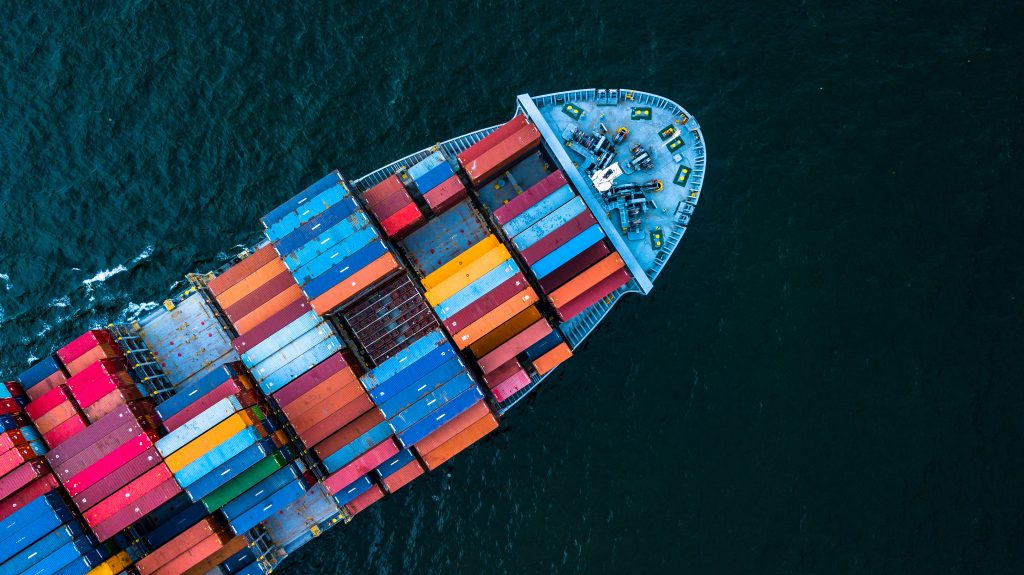Marine Shipping: Trading the Drewry Container and Baltic Dry Indices
Approximately 80% of the world’s cross-border trade is transported via the ocean, and in 2021 the rates for marine shipping services skyrocketed—some of them to record levels. Here is how to trade shipping services.

The cross-border trade of goods and services is one of the largest components of the world economy.
Known as “world trade,” this is the sum of all international imports and exports of goods and services. Data from the last five years shows that world trade consistently accounts for the majority of global gross domestic product (GDP), representing around 57% of the world’s total GDP.
The vast majority of cross-border trade is transported via the ocean. The United Nations Conference on Trade and Development (UNCTAD) estimates that roughly 80% of global trade by volume and 70% by value is transported by sea.
This data underscores the importance of the marine shipping industry to the world economy. The world economy can’t function without it.
Much like other global businesses, marine shippers ran into pandemic-related complications during the last couple years. As a result, the sector hasn’t been running at optimal efficiency.
Ultimately, this has resulted in longer shipping timelines, shipping delays, port bottlenecks and dramatically higher shipping rates—the latter of which has had a positive impact on profitability in the sector.
Types of Marine Shipping
Within the global marine shipping industry, there are effectively three major subsectors: dry bulk, container and tanker.
Dry bulk shipping covers the shipping of commodities and other unpackaged, nonliquid raw materials. Some of these include grains, iron ore, coal and lumber.
Dry bulk shipping is often subdivided into so-called major bulk goods and minor bulk goods. Major bulk goods include iron ore and coal, whereas minor bulk goods include minerals, fertilizers and steel products.
In terms of the global marine shipping fleet, the dry bulkers constitute the largest percentage of the total fleet. As illustrated below, dry bulkers represent roughly 43% of the world shipping fleet.
Source: ScienceDirect.com
As shown above, the second-largest segment of the world’s shipping fleet is occupied by oil tankers.
On any given day, upwards of 95 million barrels of oil are absorbed by the world economy, and much of that is consumed hundreds of miles from its point of origin. Oil tankers are responsible for moving this precious global energy commodity across the world’s oceans.
There are two primary types of oil tanking vessels: crude tankers and product tankers. Crude tankers transport large quantities of unrefined crude oil from its point of extraction to refineries. Product tankers, on the other hand, are designed to move refined products from refineries to hubs located near the point of consumption.
The third major subsector within the global marine shipping industry encompasses container ships. A container ship is essentially a cargo ship that carries all of its load in truck-size intermodal containers.
These days, roughly 90% of non-bulk cargo is transported using container ships. However, the container fleet is much smaller than the dry bulk and oil tanker fleets, representing only about 13% of the world’s marine shipping fleet.
Impact of the Pandemic
The marine shipping industry is a lynchpin of the global economy, so as one might expect, economic disruptions associated with the COVID-19 pandemic also led to disruptions in the marine shipping network.
Border closures during the early stages of the pandemic were a significant impediment for marine shippers, causing port delays and canceled trips. In response to these complications, marine shippers were forced to consolidate shipping routes and shrink their operations in an effort to minimize financial losses.
But then, unexpectedly, the world economy snapped back in robust fashion. Unfortunately, the marine shipping industry could no longer accommodate that level of demand. The result was an uptick in marine shipping rates, as rising demand outstripped available capacity.
Movement in the Drewery World Container Index during 2020 and 2021 provides further insight into this trend. The Drewry World Container Index serves as a reliable barometer for spot container freight rates on major East-West shipping corridors.
The chart below highlights how container shipping costs started to increase in late 2020 and then skyrocketed in 2021. Prior to the pandemic, it cost roughly $1,300 to ship a 40-foot container from Shanghai to Los Angeles. Today it costs more than $9,000 for the same service.
The above data shows that container shipping rates have moderated since peaking in the fall of 2021. Current projections suggest that this downward trend could continue, but that rates are expected to strengthen once again in late summer and early fall of 2022.
Ultimately, actual container shipping rates in the coming weeks and months will depend heavily on available supply and ongoing demand.
Another well-known gauge of global shipping rates is the Baltic Dry Index (BDI), which focuses on dry bulking rates, as opposed to container rates.
The BDI is a shipping and trade index created by the London-based Baltic Exchange. To compute the BDI, members of the exchange contact shipping brokers directly to assess price levels for various shipping paths.
Much like the Container Index, the BDI started rising during the second half of 2020, and then experienced a dramatic spike during 2021. However, as illustrated below, the BDI cratered during Q4 2021 – dropping from roughly 5,400 all the way down to 2,300.
Demand for the transport of bulk goods has tailed off in recent months. Whether that’s due to supply chain issues (i.e. nothing to ship), or a drop in demand for goods, isn’t yet clear.
As of early April, the BDI is trading around 2,000.
Impact on Marine Shipping Stocks
As one might imagine, rising shipping rates were a significant positive for the marine shipping sector.
Last year, some of the top-performing exchange-traded funds were those leveraged toward marine shipping, including the Breakwave Dry Bulk Shipping ETF (BDRY), which was up as much as 250% during 2021.
So far in 2022, BDRY has been trading relatively flat—up roughly 2% on the year.
But the frenzy in shipping rates during 2021 drew many new investors and traders to the sector, which in turn saw new offerings materialize as ETF issuers attempted to capitalize upon increased market attention on the sector.
The SonicShares Global Shipping ETF (BOAT) was launched in late summer of 2021, while the U.S. Global Sea to Sky Cargo ETF (SEA) was launched in mid-January of 2022.
SEA is composed of 29 companies from around the world that participate in the global shipping industry, of which roughly 70% are involved in ocean-faring transport. BOAT, on the other hand, is represented by 50 global maritime shipping companies. Much like BDRY, BOAT and SEA have both traded relatively flat so far in 2022.
To track and trade some of the best-known single stocks from the marine shipping industry, readers can add the following tickers to their watchlists:
- A.P. Moller-Maersk (AMKBY)
- Danaos Corporation (DAC)
- Eagle Bulk Shipping (EGLE)
- EuroSeas (ESEA)
- Genco Shipping & Trading Limited (GNK)
- Golar LNG Limited (GLNG)
- Golden Ocean Group Limited (GOGL)
- Global Ship Lease (GSL)
- International Seaways (INSW)
- Kirby Corporation (KEX)
- Matson (MATX)
- Safe Bulkers (SB)
- SFL Corporation (SFL)
- Star Bulk Carriers (SBLK)
- ZIM Integrated Shipping Services (ZIM)
To follow everything moving the markets, readers are encouraged to tune into TASTYTRADE LIVE, weekdays from 7 a.m. to 4 p.m. CT, at their convenience.
Sage Anderson is a pseudonym. He’s an experienced trader of equity derivatives and has managed volatility-based portfolios as a former prop trading firm employee. He’s not an employee of Luckbox, tastytrade or any affiliated companies. Readers can direct questions about this blog or other trading-related subjects, to support@luckboxmagazine.com.



















